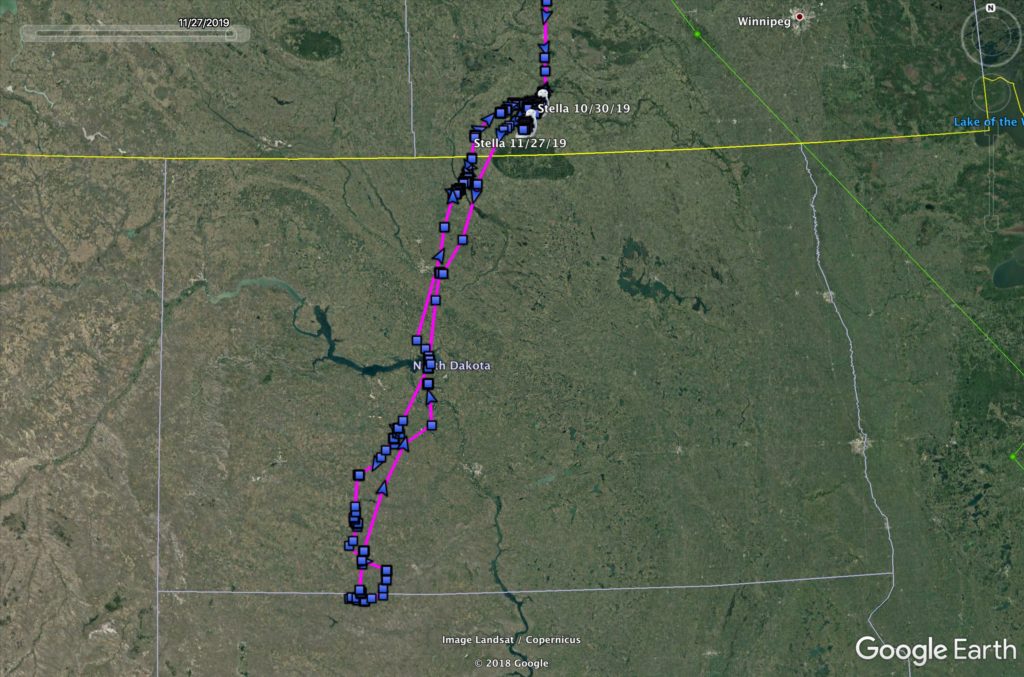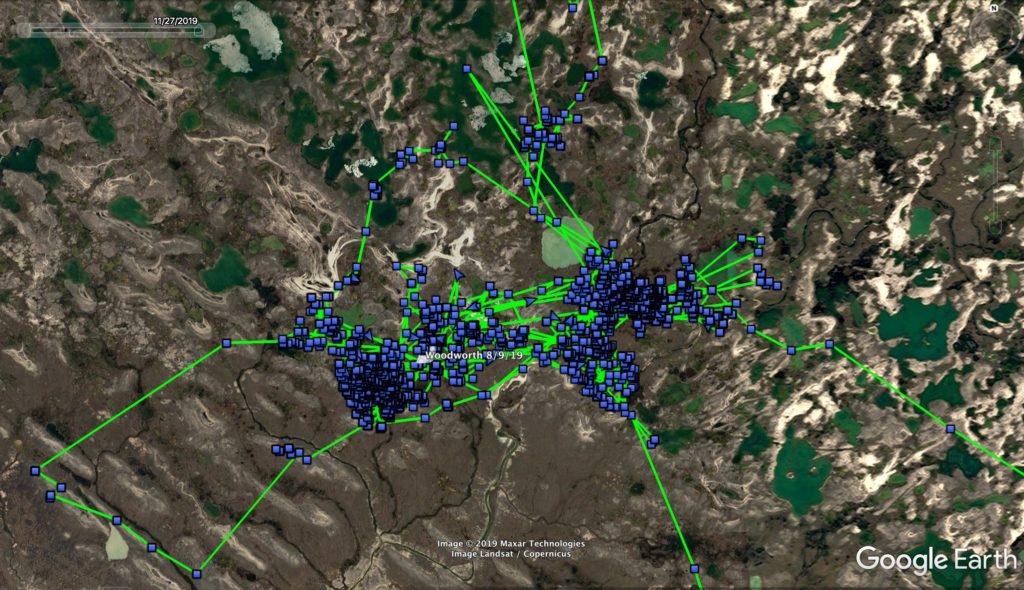
The spring/summer/fall tracks for Stella (purple), Pettibone (orange) and Woodworth (green). (©Project SNOWstorm and Google Earth)
Welcome back to the start of a new season of snowy owl research with Project SNOWstorm! This is our seventh year studying the movements and ecology of these amazing Arctic predators, and it promises to one of the most interesting ever.
We’re delighted to say that things are awfully exciting right out of the gate this year, with a number of returning owls already down from the Arctic, as well as newly tagged birds that are furthering some of our ongoing research goals, a big expansion this past summer of one of our most interesting aspects of our study, and fascinating results from our experiment with new hybrid transmitters. On top of all that, there have already been good numbers of snowy owls showing up in the northern prairies from Alberta to North Dakota, across the Great Lakes into the Ottawa and St. Lawrence valleys, and down the Atlantic coast as far as New York.
We’ll have lots more details about many of those subjects in the coming days, but let’s start today with some of the best news. Three of our tagged birds — Stella, Pettibone and Woodworth — have come back south, bringing with them recorded data that have allowed us to trace their movements over the past seven or eight months in the Arctic.
All three reappeared rather early in the fall. The evening of Oct. 23, I was surprised to get an automatic text message from the servers at CTT telling me that Stella’s transmitter had just checked in — and moments later, so did Woodworth’s. These are among the earliest returns we’ve ever had, part of a significant movement of snowy owls into the northern Plains in October on the heels of some harsh winter weather, including an early blizzard in the Dakotas. Federal wildlife biologist Matt Solensky, who originally tagged both Pettibone and Woodworth, speculated that the owls may have been following a huge migration of waterfowl pouring through the region in October.
Stella (whom we tagged in 2018 on Amherst Island in Ontario) was in southern Manitoba when she first transmitted last month, north of Boissevain and only about 40 km (25 miles) north of the North Dakota line. Her transmitter uploaded thousands of GPS locations that it had been logging since she headed north and out of cell range last April — and those data points told quite a story.
We last heard from her April 11 near Prince Albert, SK, just before she hit the southern edge of the boreal forest. From there, over the next month Stella flew north-northeast, crossing into Nunavut and looping around the western margin of Hudson Bay in late May before angling north though the Queen Maude Bird Sanctuary. Then she crossed to Victoria Island, an immense piece of Arctic real estate the size of England, Wales and Scotland but with a human population of fewer than 2,500 people.
That’s where Stella spent the summer of 2018, but she didn’t stop on Victoria this year. In mid-June she crossed 140 km (85 miles) of icy water to reach Melville Island, and continued on still farther to uninhabited Lougheed Island, one of the most isolated parts of the Canadian Arctic Archipelago. She made one foray out from the northern tip of Lougheed on June 24, toward the uttermost edge of the Canadian Arctic, but turned back to land, having flown more than 3,000 km (1,900 miles) since April. Through July and August she moved slowly south, picking up speed by the end of September and the first weeks of October.
One thing is clear from her constant travel — she definitely did not attempt to nest this year, likely the second year without a nesting attempt. She’s only a three-year-old bird, and while experts aren’t sure at what age snowies begin to breed, they suspect it may not be until about age four.

Stella didn’t like something about South Dakota. (©Project SNOWstorm and Google Earth)
Once she hit cell range in Manitoba, she kept moving south, crossing North Dakota and on Nov. 13 stuck her toe into South Dakota, near the town of Lemmon — where something must not have suited, because she hightailed it back north across all of North Dakota into southern Manitoba near Whitewater Lake, where she’s been ever since.
Pettibone, an adult male tagged in North Dakota by Matt Solensky in 2018, showed up Nov. 13 in southeastern Saskatchewan near Kelvington. He’d also spent the summer in the Canadian Arctic Archipelago, wandering around Cornwallis and Bathurst islands — and unlike the summer 2018, when we suspect he nested, this time he showed no sign of settling down in one spot and perhaps provisioning a nest. Like Stella, he was well on is way south by the end of September, and by the time he reconnected with us he’d made a round trip just shy of 6,000 km (3,700 miles).

Woodworth settled down on King William Island in the Canadian Arctic this past summer, but the size of his territory suggests this young bird was not breeding. (©Project SNOWstorm and Google Earth)
Woodworth, a subadult male whom Matt caught and tagged last winter in North Dakota, didn’t go quite as far north, stopping on the Boothia Peninsula and then backtracking to King William Island by mid-June. At first glance, his track thereafter looked good for nesting — a huge cluster of hundreds of points — but zooming in on Google Earth, he was covering thousands of acres, with three focal points many kilometers apart — an unlikely pattern if he’d been caring for chicks. Besides, Woodworth is only two years old, which like Stella is probably too young to breed.
Woodworth’s transmitter is struggling with low solar angle and short days, and transmitting almost 9,000 backlogged GPS points drained it enough that it couldn’t tell us exactly where he was at the time of transmission; his last recorded point was in western Manitoba, northwest of the northern tip of Lake Winnipeg. As his battery voltage recovers, we should start getting regular updates from him.
Look for more SNOWstorm updates in the days ahead — as I said, we have a ton of news to share, making this one of the most exciting starts to a season that we’ve ever had.


17 Comments on “A New Season, a Lot of News”
Thanks for a wonderful first update, Scott, and I’m looking forward to hearing more in the coming months.
Having checked on a few Project SNOWstorm Snowy Owl tracks in Oct and Nov, I was following Stella’s foray through ND as the data points were being posted. Hopefully more birds will check-in as the season progresses. May your server become filled with quality data from multiple birds!
Great point (and a reminder to folks) that the new map interface we rolled out last year updates automatically as we get new data, so you don’t have to wait for a blog post from us to catch up on a particular owl — just check its map page using the “Owls” drop-down menu to see what might be new.
Very exciting news. Looking forward to this season.
Just a thought: could future tags not be programmed so that the last recorded position is tranmitted first, before the test of the backlog?
Can’t wait for the rest of the season to unfold. However, I have a question. I once watched a documentary about Snowy Owls in which the lemming population was so low that the male had to hunt really far from the nest to find food for the chicks. Could it be that this was the case with Woodworth?
Was excited to get your email! I did follow Stella’s journey last year, and am glad she has transmitted again this year. Your updates are the highlight of my email! We had a beautiful Snowy in the tree next door last December 4 (shoreline of Lake Ontario in Greece, NY), have kept the photos, and crossing my fingers for her return. Thanks!
Jasja — The transmitters are already programmed to send us a current location whenever they connect, but for some reason, the last two times Woodworth’s connected it didn’t include lat/long for his location — though his transmitter managed to keep enough voltage to send more than 9,000 backlogged points in two transmissions. The best we could say was that he was in Canada, because his unit connected through the Rogers Wireless cell network.
Thank you for your reply! It is great that you can get a general place through the type of network. Let’s hope it will charge enought to send more recent data. Very exciting stuff!
Hazem — It’s possible, though the fact that Woodworth is still a fairly young bird (only in his third summer this year), combined with the movement pattern, makes us *think* he didn’t breed. But we can’t be certain. For his sake, I certainly hope he did.
excitement in our home…the owls are coming back! the owls you profile now are all very young. do our regulars return later? your hard work produces glad tidings during this run-up to Xmas…thank you so very much.
Greetings from NW Minnesota- First sighting 11/16, juvenile male on power pole S of Crookston, MN. Earliest one in several years. Just after sugar beet harvest, but during soybean harvest. Corn will come down next, providing more feeding opportunity.
I’d like to comment about Stella’s quick departure from South Dakota. On 11-3-19, I was birding with several avid North Dakota birders in the Lemmon South Dakota area. The area east of Lemmon over to McLaughlin has several large prairie dog colonies. It’s one of the few areas where prairie dogs haven’t been poisoned out or dislocated. With this abundant food supply, the number of raptors in the area was extremely high. We saw numerous species including Golden and Bald Eagles, Ferruginous Hawks, Rough-legged and Red-tallied Hawks, Prairie Falcons, and Northern Harriers. If I had my guess, I’d say that Stella got chased away or just didn’t like the competition.
Thank you to everyone that works on Project Snowstorm. And it’s supporters. I love this study!
Thanks, Diana — great to get some on-the-ground intel that sheds light on what we’re seeing remotely with the transmitter data! Snowies (especially big females) don’t let themselves get pushed around too much by smaller raptors, but they are very wary of eagles. That might very well be why she beat a retreat.
Excellent tracking maps and early reports. Thank you Scott for keeping us informed with timely reports.
Scott, thank you for all the work you and others are doing on Project SNOWStorm! Exciting work and a pleasure to read your summary. While I know it’s not a good sign when they push as far south as North Carolina, I have to confess, seeing two snowies on Ocracoke Island during the last major eruption was a thrill. I’ll look forward to watching their whereabouts this year. Wishing you, the SNOWStorm team and your Snowy Owl partners a great year!
Very excited to see some of the snowies are back already! Thanks for the update Scott, looking forward to a great SNOWstorm season.
According to local WHYY news, some snowy owls are being seen on the Jersey Coast. Do you have any news on that?
Alice, the map I’ve linked-to below will display any Snowy Owls reported by eBird users from October through December. Once we get into January, you’ll have to change the Date selectors at the top of that page to include the newer January reports.
https://ebird.org/map/snoowl1?neg=true&env.minX=-78.57357788085938&env.minY=38.095313003294024&env.maxX=-72.15756225585938&env.maxY=40.790605824720636&zh=true&gp=true&ev=Z&mr=on&bmo=10&emo=12&yr=cur&byr=2019&eyr=2019